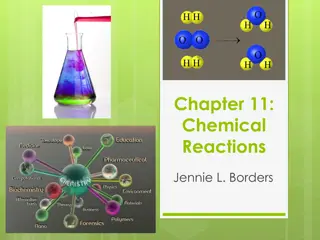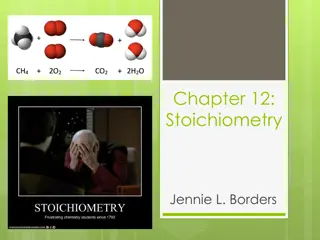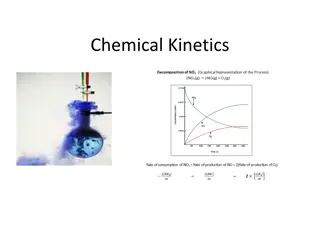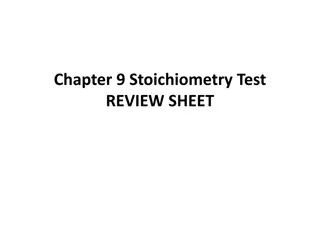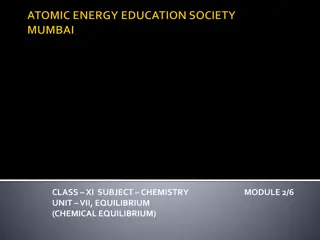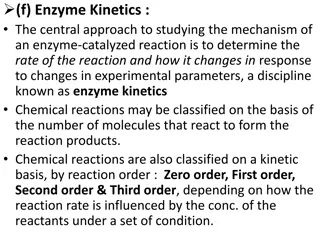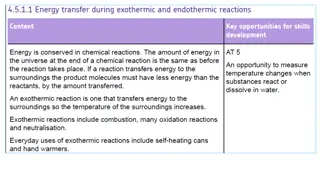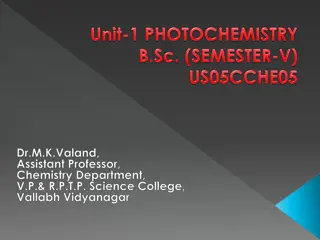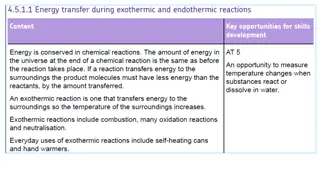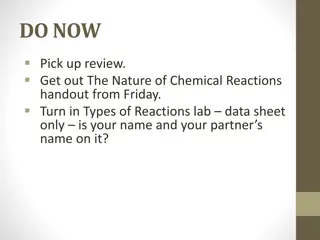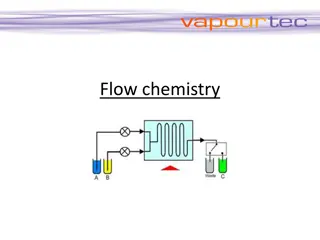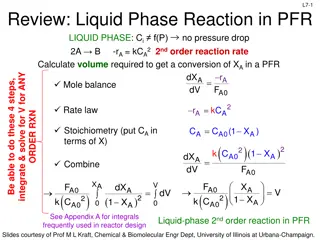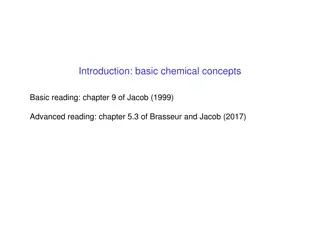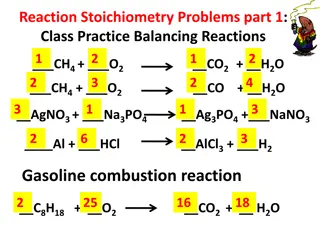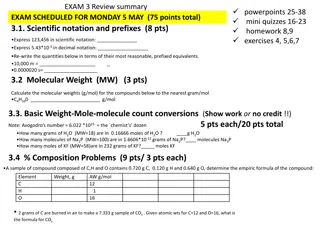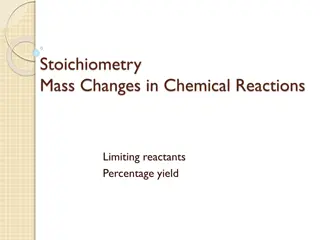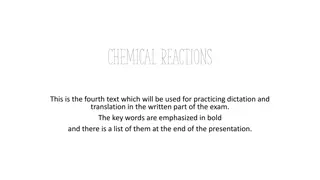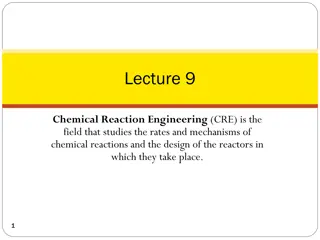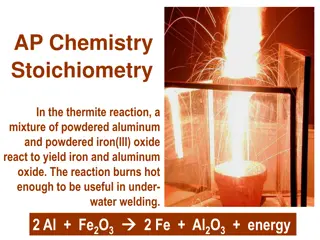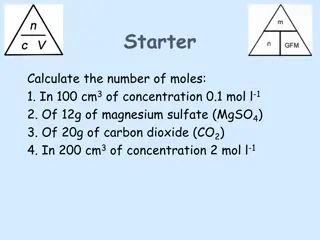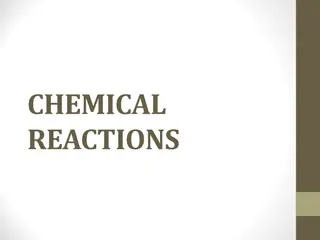Stoichiometry - The Mathematics of Chemical Reactions
Stoichiometry is a crucial aspect of chemistry, involving the quantitative relationships in chemical reactions. This concept delves into the calculations of reactants and products based on balanced chemical equations, helping to determine the amounts of substances involved. By understanding stoichiometry, one can predict the outcomes of reactions, optimize reaction conditions, and analyze reaction efficiency. Mastery of stoichiometry is essential for chemists and students to accurately work with chemicals and design experiments.
Download Presentation

Please find below an Image/Link to download the presentation.
The content on the website is provided AS IS for your information and personal use only. It may not be sold, licensed, or shared on other websites without obtaining consent from the author.If you encounter any issues during the download, it is possible that the publisher has removed the file from their server.
You are allowed to download the files provided on this website for personal or commercial use, subject to the condition that they are used lawfully. All files are the property of their respective owners.
The content on the website is provided AS IS for your information and personal use only. It may not be sold, licensed, or shared on other websites without obtaining consent from the author.
E N D
Presentation Transcript
Unit 8 Unit 8 - - Stoichiometry Stoichiometry The Math of Chemical Reactions
Recall In our last unit, we talked about how to convert between moles & mass and moles & atoms/molecules for one compound. In this unit, we will be applying these skills to convert between moles and mass of two different compounds.
What is Stoichiometry? The study of the mathematical relationships between the substances in balanced chemical reactions Allows for calculation of amounts of reactants or products in a chemical reaction i.e. How much of one thing can you make if you start with a certain amount of another thing?
Stoichiometry in Chemistry 2 2 H H2 2 + O + O2 2 2 2 H H2 2O O Coefficients Coefficients in a balanced chemical equation indicate the relative amounts of each substance involved in the reaction One way to describe the ratios reaction above would be two molecules hydrogen gas plus one molecule yields two molecules molecules of water ratios involved in the molecules of molecule of oxygen gas
Mole Ratios However, since these are only ratios same equation, 2 2 H H2 2 + O ratios, using the + O2 2 2 2 H H2 2O O It is equally true that, two moles plus one mole mole of oxygen yields two moles water These mole relationships are called mole ratios mole ratios moles of hydrogen moles of
Mole Ratio Mole ratio Mole ratio conversion factor which relates moles of one compound to moles of another compound in a balanced balanced equation Coefficients from balanced equation are used to write mole ratios N N2 2 (g) + 3H (g) + 3H2 2 (g) (g) 2NH 2NH3 3 (g) (g) mol 1 N 3 mol H 2 mol NH 2 2 3 3 mol H 2 mol NH mol 1 N 3 2 2
Mole Ratios Example #1 Example #1: What is the mole to mole ratio of oxygen to water in the following equation: 2 2 H H2 2 + O + O2 2 2 H 2 H2 2O O
Mole Ratios Example #2 Example #2: Balance the equation and then determine the mole ratio of sodium hydroxide to sodium sulfate in the following equation: ___H ___H2 2SO SO4 4 + ___ + ___ NaOH NaOH ___Na ___Na2 2SO SO4 4 + ___H + ___H2 2O O
Warm Up: 1. Balance the equation: ___Na + ___Cl2 ___NaCl 2. What is the molar ratio between Na and Cl2? 3. What is the molar ratio between Cl2 and NaCl?
Stoichiometric Calculations Mole to Mole Calculations Mole to Mole Calculations converting from moles of one compound to moles of a different compound 1. Write and balance the equation if not already done 2. Write the mole ratio between the two mentioned compounds using the coefficients from the balanced equation. This will serve as your conversion factor. 3. Use dimensional analysis & the mole ratio to convert from moles of compound #1 to moles of compound #2
Mole to Mole Calculations Ex #1 Ex #1: In the equation below, if 0.5 moles of magnesium hydroxide react, how many moles of water would be produced? 2 2 H H3 3PO PO4 4 + 3 Mg(OH) + 3 Mg(OH)2 2 Mg Mg3 3(PO (PO4 4) )2 2 + 6 H + 6 H2 2O O
Mole to Mole Calculations Ex #2 Ex #2: In the equation below, if 0.246 moles of H3PO4 react, how many moles of water would be produced? 2 2 H H3 3PO PO4 4 + 3 Mg(OH) + 3 Mg(OH)2 2 Mg Mg3 3(PO (PO4 4) )2 2 + 6 H + 6 H2 2O O
Mole Conversions WS Prob. 1 Aluminum metal and hydrogen chloride react to form aluminum chloride and hydrogen gas. How many moles of aluminum metal are needed to produce 3.33 moles of aluminum chloride?
Mole Conversions WS - Answers 1. a. 3.33 mol Al b. 1.64 mol HCl 2. a. 4.65 mol NaBr b. 1.55 mol Al(OH)3 3. a. 3.5 x 10-4 mol CH4 b. 7.0 x 10-4 mol O2
Warm-Up: Balance the following equation: __N2 + __H2 __NH3 If you have 4.5 moles of hydrogen gas, how many moles of ammonia (NH3) would you produce?
General Tips for Stoic. Problems Always convert the given value to moles as Always convert the given value to moles as your first step! your first step! Once you get to moles, you can convert to moles of the unknown Moles of unknown can then be converted to whatever final units the problem asks for (grams, liters, milliliters, molecules, etc.)
Mass to Mass Mass to Mass Calculations Calculations 1. Convert from grams of given compound to moles of given compound (using molar mass) 2. Convert from moles of given to moles of unknown (using the mole ratio) 3. Convert from moles of unknown to grams of unknown (using molar mass)
Mass to Mass Calculations Master Formula for Mass to Mass Calculations Given mass (g) 1 mol of given Coefficient of unknown (mol) Molar mass unknown (g) Coefficient of given (mol ) Molar mass given (g) 1 mol of u nkn own
Mass to Mass Calculations Ex #1 Ex #1: In the unbalanced many grams of carbon dioxide will be produced by the reaction of 108 grams of C5H12? ___ C ___ C5 5H H12 ___ O O2 2 ___ unbalanced equation below, how 12 + + ___ ___ CO CO2 2 + + ___ ___ H H2 2O O
Mass to Mass Calculations Ex #2 Ex #2: In the balanced equation below, how many grams of C5H12 would be needed to completely react with 11.5 grams of oxygen? C C5 5H H12 5 5 CO 12 + + 8 8 O O2 2 CO2 2 + + 6 6 H H2 2O O
Answers for Mass-Mass WS 1. 15.2 g KCl 2. A. 10.7 g H2 B. 60.7 g NH3 3. A. 4.2 g AgCl B. 4.6 g BaCl2
Percent Yield Theoretical yield Theoretical yield amount of product that should be formed when the limiting reactant (the reactant that runs out first) is completely used up Actual yield Actual yield the actual amount of product produced when the reaction is carried out experimentally actual yield Percent yield Percent yield = 100% theoretica yield l
actual yield Percent Yield 100% theoretica yield l Example #1 Example #1: If a student made 1.72 g of NaCl in the lab when they should have made 2.00 g, what is the percent yield?
actual yield Percent Yield 100% theoretica yield l N N2 2 + 3 H + 3 H2 2 2 NH 2 NH3 3 Example #2 Example #2: A student calculates that for the reaction above, 5.0 grams of NH3 should be produced. After carrying out the reaction, the student made 4.5 g of NH3. What is the percent yield of the reaction?
Example #3 ___ZnCl ___ZnCl2 2 + ___(NH + ___(NH4 4) )3 3PO PO4 4 ___Zn ___Zn3 3 (PO (PO4 4) )2 2 + ___NH + ___NH4 4Cl Cl (a) How many grams of zinc phosphate will be produced by the reaction of 5.00g of ammonium phosphate? (b) If a student did this reaction and produced 2.13 g of zinc phosphate, what is their % yield?
Example #3 ___ZnCl ___ZnCl2 2 + ___(NH + ___(NH4 4) )3 3PO PO4 4 ___Zn ___Zn3 3 (PO (PO4 4) )2 2 + ___NH + ___NH4 4Cl Cl (a) How many grams of zinc phosphate will be produced by the reaction of 5.00g of ammonium phosphate?
Example #3 ___ZnCl ___ZnCl2 2 + ___(NH + ___(NH4 4) )3 3PO PO4 4 ___Zn ___Zn3 3 (PO (PO4 4) )2 2 + ___NH + ___NH4 4Cl Cl (a) How many grams of zinc phosphate will be produced by the reaction of 5.00g of ammonium phosphate? (b) If a student did this reaction and produced 2.13 g of ammonium phosphate, what is their % yield?
Answers to Percent Yield WS 1. a. 33.1 g b. 56% 2. a. 8.2 g 3. 42% b. 76%
Answers to HW #5 1. 0.290 mole H2O 2. 1.68 g H2O 3. a. 1.62 g H3PO4 b. 93% (Good)
Limiting Reactant The reactant that is used up first in a chemical reaction Determines how much product can be formed by a reaction The reactant with fewer moles present at the beginning of the reaction
Excess Reactant Reactant present in a quantity that is more than sufficient to react with the limiting reactant Any reactant that remains after all the limiting reactant is used up The reactant present with more moles at the beginning of the reaction
Limiting Reactant Balloon Demo What was the limiting reactant for the first balloon? _____________________________ MMbaking soda= 84.01 g/mol NaHCO3 MMvinegar= 60.05 g/mol CH3COOH Moles baking soda: Moles vinegar:
Limiting Reactant Balloon Demo What was the limiting reactant for the second balloon? _____________________________ MMbaking soda= 84.01 g/mol NaHCO3 MMvinegar= 60.05 g/mol CH3COOH Moles baking soda: Moles vinegar:
Balloon Demo Questions Why were the third and fourth balloons the same size even though more baking soda was added to the fourth balloon? Limiting reactant 3rd balloon: Limiting reactant 4th balloon:


